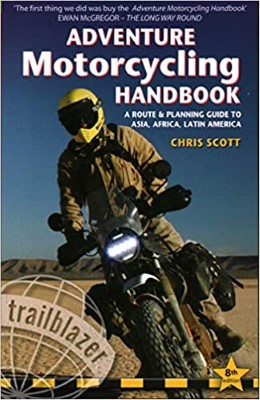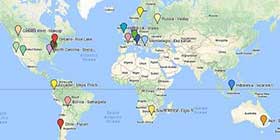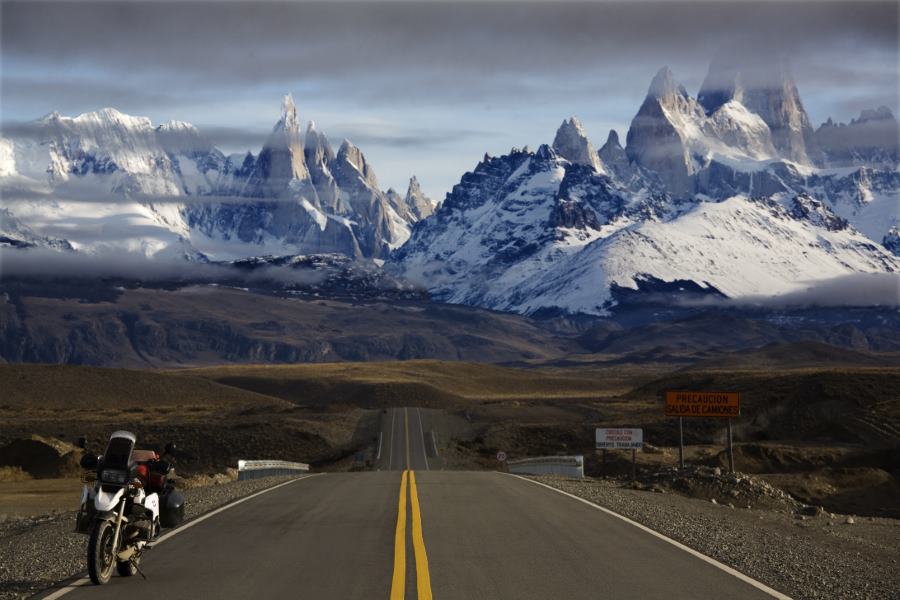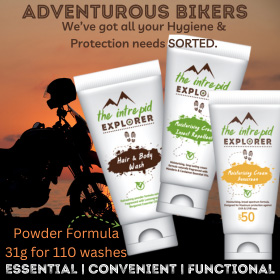 10Likes 10Likes
 |
|

26 Jan 2022
|
|
Registered Users
New on the HUBB
|
|
Join Date: Jan 2022
Posts: 8
|
|
|
Looking for a good *first* bike, for a medium sized rider, wandering around Mexico?
Hi All,
New to the forum, and new to motorcycles (not new to travel, or vehicle based adventure).
I am looking for my first motorcycle. I want something reasonably good on and off road, reasonably fuel efficient, and reasonable for a 5'8/180lb/30" inseam 30 year old rider. My budget is a target of about $4000 for the bike, with an upper limit around $5500.
So far I've been looking at the RE Himalayan, XT225 and 250, and honda CRF250/300.
Someone on ADVrider also just recommended the Versys-X 300 which I'm going to look into (but I've gravitated more towards offroad bikes that can do okay on road (dual sports), than onroad bikes that can do okay offroad (adv bikes) so far). I've also been considering the BMW F650GS Dakar, since there are a few used ones for a good price in my area, but I'm a little wary of buying an older cheaper BMW (are these bikes expensive to maintain, high maintenance, or a red flag when being sold cheap?)
Do you think that a small dual sport (250-300cc range) would be a silly choice for a first timer planning a typical ADV type trip of mostly onroad, lots of gravel/dirt road, and some true off road? Considering that (1) I'm not in a rush (2) I'm not a tall / large rider (3) I'd try to avoid interstates, but will probably do considerable travel on secondary highways (4) don't mind (and in fact prefer) going a little slower and taking scenic routes (5) but would need to carry sufficient equipment for camping/traveling for extended period of time.
Ideally a bike that was light, fuel efficient, good off road, but could do 70mph and was reasonably comfortable and stable at a sustained 65 or at least 60 would be ideal. Is this unrealistic to expect with a fully loaded 250? particularly the XT225?
Any thoughts or pointers or constructive criticism?
|

26 Jan 2022
|
|
Registered Users
Veteran HUBBer
|
|
Join Date: Aug 2014
Location: Bristol, UK
Posts: 380
|
|
|
Looking for a good *first* bike, for a medium sized rider, wandering around Mexico?
Hi Sendero
Welcome. I am sure you’ll get lots of ideas. If you are buying in North America, want off road focus (but dual use) and want to carry gear, personally i’d be looking at a suzuki dr650 or a kawasaki klr650. Not much more weight and gives more flexibility and 70mph with ease.
Cheers
Andy
|

27 Jan 2022
|
|
Registered Users
New on the HUBB
|
|
Join Date: Jan 2022
Posts: 8
|
|
Quote:
Originally Posted by Temporaryescapee

Hi Sendero
Welcome. I am sure you’ll get lots of ideas. If you are buying in North America, want off road focus (but dual use) and want to carry gear, personally i’d be looking at a suzuki dr650 or a kawasaki klr650. Not much more weight and gives more flexibility and 70mph with ease.
Cheers
Andy
|
I'm thinking a 650 might be a better second bike for me. Not sure if that logic holds water, but being a medium sized to shorter (5'8 / 30 inch inseam) rider, and a total beginner, something a little lighter and lower (or at least one of the two) seems like it might be easier/less intimidating to learn on. Do you think that is a reasonable assumption? (my only experience has been on a DR200SE which I believe is ~275lb and 32" seat height, so I have nothing to compare to)
|

27 Jan 2022
|
 |
Registered Users
Veteran HUBBer
|
|
Join Date: Dec 2012
Location: Back into the hamster wheel again, in Oslo - Norway. Did a 5 year RTW trip/250 k kms, 2014-2019
Posts: 1,565
|
|
|
I wouldnt hesitate to take a 250-300 down in Mexico (and the rest of central and south America for that matter). A Suzuki Dr650 wouldnt be bad either as its very lightweight and nimble and a well proven bike.
__________________
In the end everything will be fine. If its not fine its not the end....
Last edited by Snakeboy; 27 Jan 2022 at 02:34.
|

27 Jan 2022
|
|
Registered Users
Veteran HUBBer
|
|
Join Date: Aug 2014
Location: Bristol, UK
Posts: 380
|
|
|
Looking for a good *first* bike, for a medium sized rider, wandering around Mexico?
I agree with your focus on weight and seat height Sendero - important for building confidence. I’d stay away from 200kgs bikes for now for sure.
Once you meet your criteria on that, if you can get a bit more power it gives a bit more flexibility to travel on paved roads at slightly higher speeds. The 650 engine itself is not intimidating, if just doesn’t run out of puff as quickly. Irrelevant at 30-40mph , but more so for longer paved rides.
This is not an issue for many (as per Snakeboy’s post - he has lots of experience so helpful to know the 250/300 will work for you in Mexico/SA). Trust your gut/self-knowledge.
I recently read “Marilyn across America” by Jeff Fletcher - a short book about the trans-america trail. Quite a nice read if you like travel. He’s a new rider i think and swaps from a 250 to a 650 part way, explaining the benefits of both, if that’s of interest (on amazon/kindle)
|

27 Jan 2022
|
 |
Gold Member
Veteran HUBBer
|
|
Join Date: Oct 2005
Location: Oslo, Norway
Posts: 658
|
|
|
All the bikes you mentioned would be good. Personally I would have gone with the Honda CRF 300 Rally. The suspension is a bit too much on the plush side, and the bike doesn't have a ton of power, nor great torque for that matter. It is a typical Honda approach, not going crazy with anything - staying well within the parameters of the tried and tested, in all aspects. This translates into a durable, reliable, comfortable and inexpensive bike. It won't be perfect for anything, but a great compromise for someone who wants to do a little bit of everything.
It would be a great bike not only for Mexico, but an RTW as well. Also, it may very well become your first, second and third bike - as you can continue tailoring it over the years.
Bigger and more expensive is not necessarily better for travel - even for the experienced. I have a T7 Rally (among others). I love the bike, but for an RTW, I would seriously consider a CRF.
As for the Himalayan. I love the bike - I almost bought one, and still want one. It is so cool... and inexpensive! It can surely do the job. Then again, if one puts ones feelings aside, it isn't really a great bike in any aspect. I would have no problems riding it RTW - but know I would have wished I took something else. It is capable and fun - but not the most suitable if you can consider a slightly used bike from Honda or Yamaha (and others).
In the end though, riding a Himalayan long enough, the nostalgia will surely fade and the wish for a more suitable tool will creep up on you.
I know I'll be stepping on toes here as the Himalayan has a large fan base. But, however much I wish the bike to offer more than it can, I have to be honest. Too many aspects of that bike is a combination of nostalgia (beauty) and recycling from other bikes (cost cuting) - to the extent that it takes away more than it adds - from a bike that otherwise would have been just awesome. Just a simple stupid thing as the indents on the tank. It looks good, but it doesn't add neither leg room, knee grip or added fuel - but takes away from all of the above. There are many such examples of afterthought, cost cutting recycling, and estetics getting the better of great engineering.
|

27 Jan 2022
|
|
Registered Users
Veteran HUBBer
|
|
Join Date: Dec 2020
Location: Finland
Posts: 184
|
|
|
I was in your position a few years ago.
I went with a used Versys-x 300. The other bike I looked at was a CRF 250 rally (300 was not out then).
I would recommend either. Both are dead reliable (I have not had a single problem with mine in 35000km.). Since it's your first bike I would avoid anything heavier. A heavy bike will prevent your from exploring back roads and will be a pita when you drop it.
Biggest upside with the Versys is that it vibrates less than the CRF, so it's more comfortable. The larger fuel tank is also nice to have.
The CRF will be better off road due to the longer travel suspension and the larger wheels. CRF has a longer maintenance interval so if you are doing really long range travel that might be something to take into account.
You can't go wrong with either one.
|

27 Jan 2022
|
|
Registered Users
Veteran HUBBer
|
|
Join Date: Mar 2019
Location: UK
Posts: 488
|
|
Hi
My wife and I are having a similar discussion at the moment - neither of us are newbies by a long chalk.
Firstly, I would recommend that you check out itchy boots on you tube - went from a Himalayan to a crf250l to a 300 Rally. Bear in mind that she seeks out off road routes and did a lot of bike training during Covid - which showed inher rally riding in South Africa.
My thoughts, for what they’re worth, is that for a shorter rider the Himmy is great: easy, tractable motor, low centre of gravity coupled with a low seat height and Harris designed frame make it very easy off road, especially in mud, for the beginner - check out ‘nathen the postman’ on you tube.
However, it maybe great when riding but it is heavy and not so good for maneuvering around or getting into tight spaces or indeed picking up.
As a newbie with a 30” inseem I’d sit on a bike before I bought and made sure both my feet were flat on the ground.
In the end I wouldn’t sweat it, it’s your first trip, just go and have fun. If everything was perfect you’d have no funny stories to tell when you get back and besides you can always sell the bike and get something different next time.
Good luck

Last edited by Flipflop; 28 Jan 2022 at 11:20.
|

27 Jan 2022
|
 |
Gold Member
Veteran HUBBer
|
|
Join Date: Oct 2005
Location: Oslo, Norway
Posts: 658
|
|
|
I know a lot of beginners, as well as more experienced, are worried about not being able to flatfoot both feet, not to mention only being able to tip-toe.
It is however more of a mind over matter type thing than anything else. It doesn't take much for a vertically challenged to learn how to ride the tallest horse like it is nothing. I've coached plenty beginners to do this.
Every rider should in fact learn to ride as if they were vertically challenged - because sooner or later they will encounter a surface with a drop on either side (or both) - with the need to put a foot down. It doesn't even have to occur offroad. It can simply be from going across a slope (i e. turning on a hill), or being on top of a curb, etc. Offroad it will happen quite often even for taller people.
The techniques are simple and easy to learn, but is best taught when new and in a parking lot.
Once you have learned it, you will forever have a far greater selection of bikes to choose from. Learning it well and proper shouldn't take many hours at all. Remember when you were eight and stole dad's bicycle (because no one told your height was an issue)?
I do get that it is both useful and comforting to be able to plant both feet, but given the choice to get a bike lowered, or to keep the original ground clearance and original suspension characteristics, I would in all but a few cases choose the latter. I don't think anyone should have to compromise on wheel size, suspension or saddle.
A CRF 300 is a beginners bike in my opinion. In fact, it doesn't get much more beginner than this.
The Himalayan is a cool bike, and capable, but it is far inferior to the CRF in every aspect that comes to mind. For only a penny more you can get a bike with a ton more value. Ride enough bikes and you would in it's price bracket, not recommend the Himalayan to anyone, for any kind of purpose - unless of course it is a lot about looks and nostalgia. Whatever you intend to do with a bike, you can for the price of a Himalayan, find a more suitable alternative. This is especially true if one is willing to consider a used bike in good condition, that might have seen a season or three.
|

27 Jan 2022
|
|
Registered Users
Veteran HUBBer
|
|
Join Date: Mar 2018
Location: Portugal permanent, Sweden during summer
Posts: 486
|
|
|
Bike in Mexico
It is not clear if you are riding to Mexico. Or buying a bike in Mexico.
If you buy in Mexico: They sell the Brazilian made Hondas.
XR and XREs
https://www.honda.mx/motos/lineup
For plotting around in Mexico, I would select the XR 190L
A simple, cheap and robust bike.
https://www.honda.mx/motos/xr-190l
You do not need anything bigger.
( I have actually contact with a Honda dealer in Medellin/Colombia, for buying an XL190 i Colombia and head south. September ?)
70 mph ?? Then you are on the wrong road.
But if you think that you need a bigger bike. XRE 300 is the alternative for almost twice the price.
https://www.honda.mx/motos/xre300
Take a look at the CL150 Cargo. If you ride solo. Why have a dual seat. And not use the space for a luggage rack ?
But it takes some guts to go against the stream
A bike (in 125 cc version) that took Simon Gandolfi from Mexico to Ushuaia. And than up to New York.
https://www.amazon.com/Old-Men-Cant-...s%2C176&sr=8-6
=
It is always much better to have something that is used also locally.
Easier with parts and maintenance.
And you do not scream "GRINGO". At least not with the bike.
|

28 Jan 2022
|
|
Registered Users
New on the HUBB
|
|
Join Date: Jan 2022
Posts: 8
|
|
Quote:
Originally Posted by Erik_G

It is not clear if you are riding to Mexico. Or buying a bike in Mexico.
If you buy in Mexico: They sell the Brazilian made Hondas.
|
Planning to buy in the US. I assume this will be easier and less hassle when it comes to registration and resale.
I was previously looking at starting out in SA, and the XR190L was my first choice for a small cheap bike in Latin America.
But my current plan is to begin and end in the states (though that may evolve, who knows), so I think it'll be most practical to buy a bike in the states before leaving.
That said, I agree with this approach:
Quote:
It is always much better to have something that is used also locally.
Easier with parts and maintenance.
And you do not scream "GRINGO". At least not with the bike.
|
|

28 Jan 2022
|
|
Registered Users
Veteran HUBBer
|
|
Join Date: Apr 2008
Location: West Yorkshire UK
Posts: 1,779
|
|
|
Buy what fits and what you like. The only way is go try them for size.
You want second hand too. While I normally detest having to deal with what previous owners have done, you are going to drop this bike, break stuff, generally make mistakes. You are going to change it after a couple of trips/18 months because every bike has flaws and when your bikes flaws start to annoy you you'll trade it for one with different flaws.
The main thing to buy is petrol (and tyres).
Ignore. @wheelies broken record. The Himalayan is cheap and simple and mostly made of perfectly adequate parts. They survive India. Hondas are better made, but barely so if you abuse them. They are more complex to work on because they are designed for the road not the workshop. It's six and two threes.
Personally I'd go sit on some bikes and buy the one that's the best deal. Don't worry about the "Dual Sport" /"ADV" thing either, its just marketing BS. There are bikes you can fit knobblies to and ones you can't. There are light bikes and heavy ones. I've done more gravel on a Triumph Bonneville than any other bike, works fine so long as you wear earplugs when classic bike loons see the dinged silencers (the ones they throw away and replace with noisier ones).
Andy
|

28 Jan 2022
|
|
Registered Users
Veteran HUBBer
|
|
Join Date: Apr 2005
Location: Oxford UK
Posts: 2,116
|
|
Quote:
Originally Posted by Wheelie

I know a lot of beginners, as well as more experienced, are worried about not being able to flatfoot both feet, not to mention only being able to tip-toe.
It is however more of a mind over matter type thing than anything else. It doesn't take much for a vertically challenged to learn how to ride the tallest horse like it is nothing. I've coached plenty beginners to do this.
|
This is where I (respectably!) disagree with you. I've spent many years riding bikes that I can't 'flatfoot' (I still have two) and accommodation only goes so far. There are of course different degrees of not being able to reach the ground from both feet flat through one toe only after sliding off the seat to needing a handy kerb / rock, but if you can't get at least one foot securely on the ground without having to contort yourself you shouldn't be using that bike for a long trip.
My evidence for that conclusion is from having done it and having paid the physical (the bike falls on you when you get it wrong - and you will) and mental (you just can't face the effort that the 'acrobatics' require so you either won't stop, or more likely, won't start) price. It's not that you can't be taught techniques to get round the issue - you can, and short of bolting wooden blocks to the bottom of my boots, I've used them all. But the issue remains none the less and eventually you'll find yourself in a position where none of them help. I've been trapped under the bike where I couldn't reach down far enough to 'paddle' in deep sand and it went over on top of me, and had to push the bike down the road from an oil strewn adverse camber filling station to find flat ground. On a long solo trip this stuff can be soul destroying.
As it's unlikely any of us can add four inches to our leg length in any practical way you're left with having to adapt the bike either by lowering a high one or buying something lower in the first place. Don't just head off on something too high and hope it'll be ok. Your mind might beat your matter into submission (!) while you're fresh and enthusiastic but eventually you'll have a day where you're tired / hot (or worse, cold) / hungover etc and it'll go wrong.
|

28 Jan 2022
|
|
Registered Users
Veteran HUBBer
|
|
Join Date: Mar 2019
Location: UK
Posts: 488
|
|
|
I believe the the factor in this case is the same as every question in life:
Everyone is different, what are you like?
There are new riders who take off with inappropriate bikes, sink or swim and come out either way with a smile on their face.
Equally, there are riders with 25+ years riding experience who are still nervous of being out of their comfort zone - doesn’t mean they don’t want to though and, many of them do.
So, ask yourself the question and answer with honesty. In the end you’re doing the trip for you, for your enjoyment.
One thing I note when reading moto-travel blogs and books is how little the bike actually features. It’s really only when it brakes down is the focus on the bike. Also people often meet up with other riders and there’s a mixture of bikes - very rarely are there negative comparisons. 1 exception is Nathen Millard on his 110cc bike but that’s riding across the US.
|

28 Jan 2022
|
 |
Gold Member
Veteran HUBBer
|
|
Join Date: Oct 2005
Location: Oslo, Norway
Posts: 658
|
|
|
@backofbeyond - I highly respect your wizdom on a lot of things. I can also somewhat agree that the Himalyan is a good and quite capable bike for its price point. It has proven itself and has also been improved upon. I can also agree that being able to flat foot a bike is better than not. But, neither is the point I'm trying to make.
The point is that for this ammount of money, there are better options - several which are Japanese dual sports. The other point is that "reach" is one of many bike attributes thad may have to be traded for another (you can't allways have it both ways). In this particular case it is "reach" vs "nimbleness".
As for a bike made for the workshop. Sure, the Himalyan is simple to work on when compared to many high tech bikes on the market today. But, working on a basic Honda like the CRF is not like working on a space shuttle - it is quite simple as well. Even a noob to a wrench should not shy away against turning it on either. I don't think the "wrenchability" difference in this case is large enough that it should influence the choice.
As for durability - I'm unsure. I'm confident that the Honda will at a bare minimum do atleast 50.000,-/kms before anything major will have to be done to it, and probaly double that (i.e. a top end rebuild... which really sin't all that difficult on a thumper - even for a noob). The Himalyan has its robustness and simplicity going for it - but it is allmost an entirely new "platform" from ground up, with little inheritance (here yyou must conscider that most of RE's other bikes were some sort of relative to the Bullet - which we all must agree is very much absolete on most performance attributes).
The Himalyans seems robustly built. In the early versions there were several reports of the bike braking in half (near the steering). Ofcourse they have remedied this "ages" ago. You are probably right on this point though - the Himalyan can withstand a beating better than a bike that was built to be light. But, keep in mind - the Himalayan "platform" (and just about everything on it) is allmost entirely "new" design - from the ground up - to catch up from decades lying behind with the Bullet, etc. The new RE is not tried and tested to the extent of the dual sports that has descended from a very long heritage of similar bike (i.e. the Honda CRF).
The CRF - is based on generations of continuous improvement from Honda. The CRF is also made by the manufacturer in the world that produce more bikes than anyone out there. Hondas are in general reputed to be the amongst the most reliable bikes, and for not going crazy by trying to squueze too much juice out of every bike - leaving a great deal of safeguards against obuse, etc. Further still - its tremendous world wide retail network assures access to both parts and knowledge accross the globe (not that the Royal Enfield network is terrible - but it doesn't come even remotely close). When it comes to predicting which bike is more likely to be operable most of the time, we have to look even beyond reliability, durability and parts accesability - we also have to conscider hthe degree of suitability for the type of riding the bike is to endure..
The Himalayan might be built like a tank. But, it is a relatively heavy and "clumsy" tool in comparison to most dual sports on the market today. So, it is not only a matter of how durable the bike is in the event of let's say a crash - but also staying out of trouble in the first place. Being able to flat foot is only one of several attributes that may dictate the outcome.
Being able to flat foot a bike may help you in preventing you from dropping it - but so will a bike that is more nimble. If you are vertically challenged, it is a tradeoff-decisicon that usually will have to be made. That much said - there will most likely be cases where you won't be able to flatt foot a bike, regardless of how long your legs are. In these cases, having "sliding off the side of the saddle technique" thoroughly engrained, or a nimble bike - are the only two things you can pray on to save you. What happens if you find that you have to put your feet down while your wheels are on a 2-3 inch high protrusion in the terrain? Will your legs be too short to catch the toppling bike?
Sure, every inch of leg counts when trying to make the reach - long legs is a good thing to have. But, if you are to venture off road, and you don't know how to ride or stop a bike without reaching the ground with both feet - you will topple a whole lot more often than if you did. And, when you have learned this teqhnique, plus/minus and inch or two won't make a huge difference. Sure there comes a point when reach becomes a real struggle - I'm not saying it doesn't matter. What that point is is however highly personal snd depends on a lot of factors (experience, physique, what type of terrain to be ridden and in what manner, as well as other bike charactersitics than simply height). Take a trip to the local MX track and look at all the teens riding horses so tall that they can't even reach the ground on even one side without sliding way out of the saddle. They all have the option to go for a shorter horse. The reason they don't is because the horter bikes simply cannot do the same things as well as the taller ones (and in part because their parents buy them a bike they can grow into). Ok, so we are not spring chickens that plan to do acrobatics on our bikes - but travel at a leasurly pace. Still, the point about not fretting too much over a slight reach problem still stands.
Now, let's say you had to cross a rocky river bed with a bit of current in it. Let's say you had the option of riding a light nimble bike with a 21 inch wheel, great ground clearance, great suspension for the task, and allmost perfect offroad ergonomics (CRF) ... or you could take another piece of equipment that also had 21" wheel, but that was coomparativekey far heavier, relatively more "clumsy" and with far poorer offroad rider ergonomics, poorer suspension, and less ground clearance??? Which would be the best tool for the job, even for a person that stuggled with reach on the first choice of bike?
Even though one could flat foot the Himalayan and barely reach on the CRF - I'd bet that the one riding the CRF would be the one most likely to get across without getting into the drink. In a river crossing scenario, attempting to paddle the bike across rather than riding it standing up might be your worst option. The same goes for a whole lot of other scenarios you may encounter once you leave tarmac. I.e. like going up or down a steep gravel road in terrible condition (ruts or rocks). In such cases, being able to flat foot may do didly for you. If you at all would be so lucky to not drop the bike, or get into a more serious accident - you will have to face the problem of getting going again with twice the hazard. What matters most is being able to traverse obstacles without having to put both your feet down in the first place. Simply being able to "dab" one foot is all that is really necessary.
As for traversing terrain, the Himalyan should be more than adequate in most cases - insignificantly inferior to the dual sports. But in other cases, the difference will be more than noticeable.
I felt that I had to voice my opininon of "reach" because too many voice the opposing view view. Many that voice the other are just parroting what the masses are parroting - because they believe the masses must be right. I mean, who can blame them - a thousand "Yay-sayers" must be more right than the one single "Nay-sayer" - right? The problem in this case is that the original source derives predominately from riders who has hardly ever left the tarmac - like the teacher at drivers ed! The eccho chamber of parrots has turned this craze of "it is really important that you can flatfoot your bike" into a false truth... well, not entirely false, but far more than is justifiable (leg length matters... a bit). So, when people try to sell someone into the idea that being able to flat foot a bike is one of the most important attributes to look for in a bike, my answer to that is: "Maybe, but probably not".
On a final note - I just don't know how a 30" inseam translates in practical terms on the CRF vs the Himalayan - i,e the seat width of each, etc. So, I should be careful to sell the CRF as the right bike for someone with a 30" inseam. In the end I hope there is a a cent worth of wisdom in all this rambling of mine, and that I do not just come across as argumentative or as a guy with a broken record. In the end, either bike may prove to be the better option for this particular person. Just don't be affraid to question any predispositions regarding "reach" (one way or the other). It may matter a lot or nothing at all when all decision criterias are conscidered.
|
|
Currently Active Users Viewing This Thread: 1 (0 Registered Users and/or Members and 1 guests)
|
|
|
 Posting Rules
Posting Rules
|
You may not post new threads
You may not post replies
You may not post attachments
You may not edit your posts
HTML code is Off
|
|
|
|

Check the RAW segments; Grant, your HU host is on every month!
Episodes below to listen to while you, err, pretend to do something or other...

2020 Edition of Chris Scott's Adventure Motorcycling Handbook.
"Ultimate global guide for red-blooded bikers planning overseas exploration. Covers choice & preparation of best bike, shipping overseas, baggage design, riding techniques, travel health, visas, documentation, safety and useful addresses." Recommended. (Grant)

Led by special operations veterans, Stanford Medicine affiliated physicians, paramedics and other travel experts, Ripcord is perfect for adventure seekers, climbers, skiers, sports enthusiasts, hunters, international travelers, humanitarian efforts, expeditions and more.
Ripcord Rescue Travel Insurance™ combines into a single integrated program the best evacuation and rescue with the premier travel insurance coverages designed for adventurers and travel is covered on motorcycles of all sizes.
(ONLY US RESIDENTS and currently has a limit of 60 days.)
Ripcord Evacuation Insurance is available for ALL nationalities.
What others say about HU...
"This site is the BIBLE for international bike travelers." Greg, Australia
"Thank you! The web site, The travels, The insight, The inspiration, Everything, just thanks." Colin, UK
"My friend and I are planning a trip from Singapore to England... We found (the HU) site invaluable as an aid to planning and have based a lot of our purchases (bikes, riding gear, etc.) on what we have learned from this site." Phil, Australia
"I for one always had an adventurous spirit, but you and Susan lit the fire for my trip and I'll be forever grateful for what you two do to inspire others to just do it." Brent, USA
"Your website is a mecca of valuable information and the (video) series is informative, entertaining, and inspiring!" Jennifer, Canada
"Your worldwide organisation and events are the Go To places to for all serious touring and aspiring touring bikers." Trevor, South Africa
"This is the answer to all my questions." Haydn, Australia
"Keep going the excellent work you are doing for Horizons Unlimited - I love it!" Thomas, Germany
Lots more comments here!

Every book a diary
Every chapter a day
Every day a journey
Refreshingly honest and compelling tales: the hights and lows of a life on the road. Solo, unsupported, budget journeys of discovery.
Authentic, engaging and evocative travel memoirs, overland, around the world and through life.
All 8 books available from the author or as eBooks and audio books
Back Road Map Books and Backroad GPS Maps for all of Canada - a must have!
New to Horizons Unlimited?
New to motorcycle travelling? New to the HU site? Confused? Too many options? It's really very simple - just 4 easy steps!
Horizons Unlimited was founded in 1997 by Grant and Susan Johnson following their journey around the world on a BMW R80G/S.
 Read more about Grant & Susan's story
Read more about Grant & Susan's story
Membership - help keep us going!
Horizons Unlimited is not a big multi-national company, just two people who love motorcycle travel and have grown what started as a hobby in 1997 into a full time job (usually 8-10 hours per day and 7 days a week) and a labour of love. To keep it going and a roof over our heads, we run events all over the world with the help of volunteers; we sell inspirational and informative DVDs; we have a few selected advertisers; and we make a small amount from memberships.
You don't have to be a Member to come to an HU meeting, access the website, or ask questions on the HUBB. What you get for your membership contribution is our sincere gratitude, good karma and knowing that you're helping to keep the motorcycle travel dream alive. Contributing Members and Gold Members do get additional features on the HUBB. Here's a list of all the Member benefits on the HUBB.
|
|
|

















 10Likes
10Likes









 Linear Mode
Linear Mode










